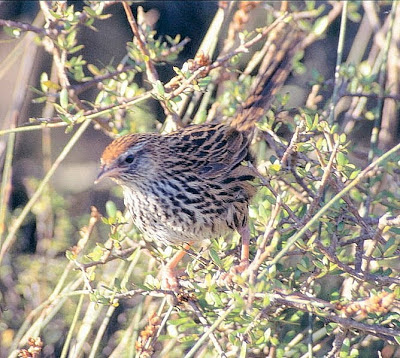NEW ZEALAND No. 2
Following on from our earlier posting on our six week visit to New Zealand in 2005.
Tui Prosthemadera Novaeseelandiae
Tui in a garden at Bushy Point.
Endemic to New Zealand, it has a wide distribution ranging from Subtropical Kermadec Islands to the Sub-Antarctic Auckland Islands. It is common and frequently seen in gardens. Its normal diet is nectar although both fruits and insects are frequently eaten, and its is closely related to the Australian Honeyeater family.
New Zealand Bellbird Anthornis melanura
New Zealand Bellbird on Tiritiri Mantanga Island.
Endemic to New Zealand with four subspecies, unfortunately the Chatham Island Bellbird is now extinct. It is found throughout New Zealand apart for the northern tip of North Island. Its distinctive bell like call is one of the main components of the dawn chorus. It is reasonably common, although it has suffered some decline due to removal of forests for farming purposes and the introduction of predators such as stoats,weasels and rats.
New Zealand Fernbird Poodytes punctatus
New Zealand Fernbird at Bushy Point.
After we came off Stewart Island, we stayed with Jenny and Ian at Bushy Point near Invarcargill. In their grounds they have created a small nature reserve which held several pairs of Fernbirds.
The New Zealand Fernbird is endemic to New Zealand, and it is chiefly a ground-dwelling bird and is a reluctant flyier. The are four sub-species and it has been discussed that the North Island Fernbird and the South Island Fernbird should be split as full species.
Buller, in his famous 18th century book on New Zealand birds stated that the Fernbird was common, but unfortunately it has now become a lot rarer due to the destruction of its wetland habitat.
The Snares Island Fernbird which inhabits the Snares Sub Antarctic Island has recently been split as a full species, and on an earlier trip, and we were fortunate enough to see one on Snares Island.

Two views of the Fox's Glacier which we drove past.
Tongariro National Park
Arriving on Tiritiri Mantanga Island
Two coastal views on Tiritiri Mantanga Island.
Australasian Swamphen Porphyrio melanotus.
Australasian Swamphen near Bushy Point
In New Zealand this Swamphen is known as the pukeo. There are five subspecies and it has a large range from Eastern Indonesia, Papua New Guinea, Australia and New Zealand. It was at one time considered to be a race of the Purple Swamphen. It has been present on New Zealand for almost a 1,000 years and it is very tame. During our trip we saw a number of birds, chiefly walking around on lawns .
South Island Takahe Porphyrio hochstetteri
South Island Takahe on Tiritiri Mantanga Island.
The Takahe was thought to be extinct from 1898, but it was re-discovered in 1948 in an isolated valley in the Murchison Mountains. Its average overall length is 25 inches and it weighs approx. 6 lbs.
The New Zealand Dept. of Conservation commenced a Takahe recovery program with native populations established on several off-shore islands as well as in Takahe Valley.
There is also a second mainland site now established, and in October, 2019 the population has risen to 48 individual birds.
Stichbird Notiomystics cincta
Stichbirds were endemic to North Island and adjacent offshore islands, but it then became extinct on the mainland and many of the offshore islands by 1885, mainly through the introduction of rats and stoats etc., with only a small population surviving on Little Barrier Island. Since then, birds have been transferred to other Islands and numbers have increased, although they are still classified as vulnerable.
Red-Fronted Parakeet Cyanoramphus novaezelandiae
Red-Fronted Parakeet on Tiritiri Mantanga Island.
Endemic to New Zealand, Originally common, but by 1890 the population started to decline due to habitat destruction and the introduction of predators including rats and cats. On the mainland it is now scarce, but is commoner on several of the offshore islands.
Spotless Crake Porzana tabuensis
Spotless Crake with a black downy young on Tiritiri Mantanga Island.
Whilst we were on Tiritiri Mantanga Island, we had the good fortune to find a Spotless Crake with one downy black chick around a small pool. Spotless Crakes has a widespread range in the Pacific region and is reasonably common, extending from the Philippines to Polynesia. In New Zealand, it has a patchy distribution throughout the North Island and is considered rare on the South Island, and they are also present on a number of the offshore islands including Tiritiri Mantanga Island.

















